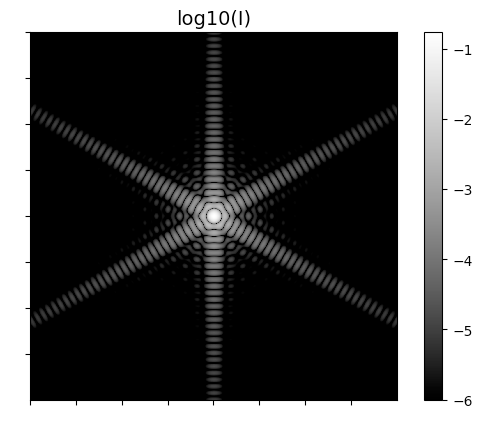This is a partial answer.
Each small mirror will impose its own strong six-spiked diffraction pattern in the telescopes point-spread function. For telescope apertures build from a large number of hexagonal mirrors this will dominate the point-spread function.
The choice of pattern for the tiling of small mirrors to fill the full aperture will have a much smaller effect.
JWST simulated point spread function from James Webb Space Telescope User Documentation's [NIRCam Point Spread Functions](https://jwst-docs.stsci.edu/near-infrared-camera/nircam-predicted-performance/nircam-point-spread-functions)
[](https://i.sstatic.net/mCA4n.jpg)
I found an analytical expression for the diffraction pattern from (or at least the Fourier transform of) a single hexagonal aperture (or flat mirror) in [this answer](https://physics.stackexchange.com/a/9910/83380) to *How does Fraunhofer diffraction depend on the orientation of the sides of a lens?* in Physics SE.
>Hexagonal aperture. I take the following function:
$$ \begin{split}
h(x,y) = \left[\theta(2y+\sqrt{3})-\theta(2y-\sqrt{3})\right]\cdot
\left[\theta(y-\sqrt{3}(x-1))-\theta(y-\sqrt{3}(x+1))\right]\cdot\\
\left[\theta(y-\sqrt{3}(-x-1))-\theta(y-\sqrt{3}(1-x))\right]
\end{split}$$
With $\theta(x)$ -- is a [Heaviside step function][2].
While it is in principle possible to calculate the Fourier transform of this by hand, I've just fed it to CAS and I've got something like this:
$$\frac{2\sqrt{3}\omega_x\left(\cos\frac{\omega_x}{2}\cos\frac{\sqrt{3}\omega_y}{2}
-\cos\omega_x\right)-6\omega_y\sin\frac{\omega_x}{2}\sin\frac{\sqrt{3}\omega_y}{2}}
{\pi \omega_x(\omega_x^2-3\omega_y^2)}$$
...plus some singular terms that I've dropped.
Plotting square of the result (from -100 to 100)
Here's my plot and a python script based on that expression:
[](https://i.sstatic.net/T3yWE.png)
import numpy as np
import matplotlib.pyplot as plt
def hexamp(omx, omy):
"""diffraction amplitude hexagonal aperture from
https://physics.stackexchange.com/a/9910/83380"""
C, S = np.cos, np.sin
rt3 = np.sqrt(3)
term_1 = 2 * rt3 * omx * (C(omx/2.)*C(rt3*omy/2.) - C(omx))
term_2 = -6 * omy * S(omx/2.) * S(rt3*omy/2.)
bottom = np.pi * omx * (omx**2 - 3.*omy**2)
return (term_1 + term_2)/bottom
omega = np.arange(-100, 100, 0.1)
omx, omy = np.meshgrid(omega, omega)
amplitude = hexamp(omx, omy)
I = np.abs(amplitude)**2
if True:
plt.figure()
plt.imshow(np.log10(I), cmap='gray', vmin=-6)
plt.gca().set_aspect('equal')
plt.gca().axes.xaxis.set_ticklabels([])
plt.gca().axes.yaxis.set_ticklabels([])
plt.colorbar()
plt.title('log10(I)', fontsize=14)
plt.show()